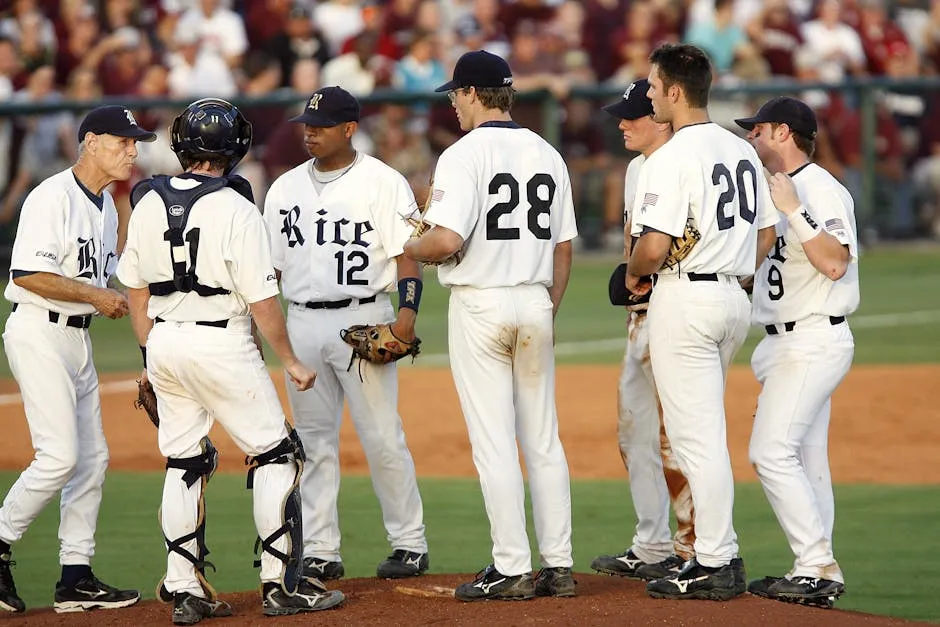Introduction
UCF baseball is a hidden gem in the NCAA landscape. The Knights have made quite a name for themselves, often dazzling fans with their spirited play and impressive stats. In the 2023-2024 season, the Knights boasted a record of 37-21, finishing 8th in the competitive Big 12. This was a significant leap, considering they were predicted to finish 10th in preseason rankings. Rich Wallace, the new head coach, took the reins this season and guided the team into the NCAA tournament, proving that change can bring fresh perspectives and successes.
Now, with a solid foundation laid, the question arises: How can we forecast UCF’s future performance based on their past statistics and emerging trends? The answer often lies in data analytics and sabermetrics. These tools are like magic wands for coaches and analysts, helping them predict player performance and team outcomes with uncanny accuracy.
Using data analysis, we can identify patterns—like batting averages, on-base percentages, and pitching statistics—that shed light on what to expect in the coming seasons. For instance, analyzing player performance from previous seasons allows us to gauge how well they might perform in the future. As we dive deeper into the world of analytics, we see how crucial these insights can be for making informed decisions about training, game strategies, and player acquisitions.
In this post, we will explore how these forecasting methods can be applied to UCF baseball. We’ll take a closer look at the key metrics that are essential for evaluating player performance and team dynamics. Get ready to unravel the fascinating world of baseball statistics and discover how they can illuminate the path ahead for the Knights!

Summary Section
To accurately forecast UCF’s baseball performance, leveraging data and analytics is paramount. The Knights’ recent achievements signal a promising trajectory, but understanding the nuances of their performance is essential. Key metrics, such as batting averages and on-base percentages, will be pivotal in assessing player contributions.
Batting average is a fundamental statistic that reflects a player’s hitting proficiency. It’s calculated by dividing the number of hits by the number of at-bats. However, it’s crucial to consider other metrics, like on-base percentage (OBP), which accounts for walks and hit-by-pitches, providing a fuller picture of a player’s ability to reach base. Pitching statistics, including earned run average (ERA) and fielding independent pitching (FIP), will also be analyzed to gauge the effectiveness of the Knights’ hurlers.
Coaching strategies play a vital role in team performance. With Rich Wallace at the helm, his approach to game management and player development will significantly impact the Knights’ success. Additionally, player changes—whether due to graduation, transfers, or injuries—can alter team dynamics dramatically. For instance, key injuries can derail a promising season, while new recruits can inject energy and talent into the lineup.
As we move forward, we’ll unveil innovative forecasting techniques that incorporate advanced analytics and machine learning methods. These tools will enable us to predict outcomes more accurately, helping fans and analysts alike understand what the future holds for UCF baseball. The upcoming sections will provide a comprehensive look at how these metrics and strategies will shape the Knights’ performance in the seasons to come. Stay tuned—there’s a lot more to uncover!

Understanding UCF Baseball’s Current Landscape
Recent Performance Analysis
The 2023-2024 UCF baseball season was a rollercoaster ride for the Knights. With a final record of 37-21, the team finished 8th in the Big 12, a remarkable feat considering they were initially picked to land 10th in preseason rankings. They made a splash by securing a spot in the NCAA tournament, although they faced a heartbreaking exit in the Tallahassee Regional, ending with a 2-2 record.
This season’s performance marked a significant improvement over previous years, as UCF showcased their potential against tough competition. Their RPI hovered in the low-30s, which is a strong indicator of their competitive edge. This was not just a season of survival; it was a testament to the team’s resilience and ability to rise above expectations.
Individual player statistics further highlight this success. Batting averages soared, with several players exceeding the .300 mark. The pitching staff demonstrated promise as well, with impressive earned run averages (ERA) that kept opponents at bay. These stats are not just numbers; they reflect the hard work and dedication of the players and coaching staff.
Historically, UCF has seen ups and downs, but this season stands out as one of their most successful in recent memory. The Knights are building a foundation that shows they can compete with the best. As they gear up for future seasons, their performance this year serves as a strong springboard.

Key Players and Coaching Changes
One of the most exciting aspects of this season was the emergence of key players who have decided to return. Their experience will be invaluable as UCF looks to capitalize on this momentum. Among them is the standout infielder Alex Freeland, known for his exceptional defensive skills and ability to hit in clutch situations. He consistently anchored the infield and provided leadership, which is crucial for team cohesion.
In addition to returning players, new recruits have joined the roster, bringing fresh talent and energy. Among the newcomers is a highly touted pitcher whose skills have already garnered attention. This mix of seasoned players and promising recruits creates a competitive atmosphere that bodes well for UCF’s future.
A pivotal factor in this season’s success has been the impact of head coach Rich Wallace. His strategic approach and ability to manage the pitching staff were crucial in guiding the Knights to the NCAA tournament. Wallace’s coaching experience and innovative strategies have inspired players to elevate their performance. This year, he demonstrated a knack for making the right calls at critical moments, a skill that every successful coach must possess.
Speaking of elevating performance, every player needs the right gear to shine on the field. A quality baseball bat can make all the difference in a player’s game. Whether you’re hitting home runs or just trying to make contact, having the right bat can boost confidence and performance. Don’t let your swing suffer—invest in a bat that fits your style!
The coaching staff’s experience is a secret weapon. They understand the nuances of player development and game outcomes. Their guidance has empowered players to refine their skills and elevate their gameplay. As the Knights look to build on this foundation, the synergy between returning players, new recruits, and the coaching staff will be essential in shaping the team’s future success.
Rich Wallace’s leadership also fosters a culture of accountability and commitment. Players are encouraged to push their limits and strive for excellence. This culture is becoming a hallmark of UCF baseball, setting the stage for future triumphs. With the right mix of talent and leadership, the Knights are poised to make a significant impact in the upcoming seasons.
As UCF baseball continues to evolve, the blend of seasoned veterans and fresh talent under the guidance of an innovative coaching staff will remain a focal point. The upcoming seasons promise to be exciting, with the potential for UCF to solidify its place as a contender in the Big 12 and beyond.

Introduction to Sabermetrics
Sabermetrics is the statistical analysis of baseball. It provides teams with a competitive edge by predicting player performance. The term originated in the early 1980s, but the practice dates back nearly two centuries. Before sabermetrics, baseball analysis relied heavily on traditional stats. But as the game evolved, so did the methods of evaluation.
In the past, players’ performances were often described by simple metrics like batting average and home runs. Today, advanced analytics reveal deeper insights. Teams now use sabermetrics to assess everything from batting tendencies to pitching effectiveness. This transformation has changed how teams build rosters and develop strategies.
Sabermetrics has also made baseball more engaging for fans. Understanding a player’s value goes beyond just watching them play. With sabermetrics, fans can appreciate the intricate details of the game. As the field continues to grow, the marriage of stats and strategy remains essential. Coaches and analysts can now make informed decisions that could alter the course of a season.
And while we’re on the topic of enhancing performance, why not consider investing in baseball gloves? A good glove is essential for making those game-winning catches and plays. Whether you’re in the outfield or at first base, having the right glove can enhance your fielding skills and keep those errors at bay!

Forecasting Techniques and Tools
Advanced Statistical Models
Baseball forecasting has entered a new era, thanks to advanced statistical models. Linear regression and machine learning are leading the charge, transforming how we analyze player performance.
Linear regression is like a crystal ball for predicting outcomes. It uses historical data to establish relationships between variables. For instance, a player’s batting average, on-base percentage, and home run count can be plugged into a model to forecast future performance. This method isn’t just for the stat nerds; it’s user-friendly and effective.
Machine learning takes it up a notch. It uses algorithms to learn from data patterns. It’s like having a super-smart assistant who gets better at predicting outcomes the more you feed it. For example, by analyzing data from players’ past seasons, machine learning can identify what factors led to a player’s success or failure. This allows teams to make informed decisions on who to sign, trade, or bench.
Take the example of a UCF baseball player who consistently has a high exit velocity. By applying these models, analysts can predict whether that player will maintain or improve their performance in the upcoming season. Historical data combined with cutting-edge techniques can reveal insights that might not be visible at first glance.

Emerging Technologies in Baseball Analytics
Emerging technologies are revolutionizing how teams track performance. Tools like Statcast and wearable technology are paving the way for deeper insights. Statcast is a game changer; it tracks everything from pitch velocity to player speed with high precision. This data allows teams to assess player performance in real-time.
Wearable technology takes it a step further. By collecting data on a player’s biomechanics, coaches can tailor training regimens to prevent injuries. Imagine knowing exactly how a pitcher’s arm moves during delivery. This knowledge helps in perfecting mechanics, reducing the risk of injury, and enhancing performance.
For example, a pitcher wearing a smart sleeve can gather data about arm angle and speed. If the sleeve detects unusual patterns, it can alert coaches to potential injury risks. This proactive approach is vital in a sport where injuries can derail a promising season.
Moreover, these technologies help in player evaluations. Teams can now quantify a player’s defensive range or batting power with unprecedented accuracy. This data is invaluable for making roster decisions, securing trades, or scouting new talent.
And speaking of scouting talent, don’t overlook the value of baseball training equipment. Whether it’s agility ladders, weighted balls, or batting tees, investing in quality training aids can elevate a player’s game to new heights. Help players develop their skills and keep them motivated to train harder!

Case Studies
Real-life success stories illustrate the power of analytics in baseball. One notable case is the Houston Astros. By embracing advanced analytics and data-driven strategies, they transformed their team into a powerhouse. The Astros utilized machine learning algorithms to analyze player performance, leading to their 2017 World Series victory.
Another example is the Oakland Athletics, famously highlighted in “Moneyball.” They used sabermetrics to identify undervalued players, leading to their 20-game winning streak in 2002. Their approach proved that a focus on analytics could yield tremendous results, even when resources are limited.
UCF baseball can learn from these teams. By implementing advanced statistical models and emerging technologies, they can refine their strategies. Making data-informed decisions can enhance roster performance and game strategies. The insights gained from these case studies underline the importance of analytics in shaping a successful baseball program.
As UCF looks to the future, harnessing these forecasting techniques will be crucial. By leveraging advanced models, emerging technologies, and learning from successful case studies, the Knights can position themselves as contenders in the Big 12. The path ahead is bright, and the potential for greatness is within reach.
Practical Applications for UCF Baseball
Incorporating Analytics into Training and Strategy
UCF baseball is at the forefront of a new era—one where data analytics reign supreme. The Knights can seamlessly integrate analytics into their coaching practices, enhancing training and game strategies. Coaches can analyze player performance metrics, identifying strengths and weaknesses. Imagine a coach armed with insights about a player’s swing speed or pitch velocity. This data allows tailored training regimens that focus on individual improvement.
For instance, by tracking batting averages and exit velocities, coaches can adjust hitting drills. If a player struggles with low exit velocity, specific drills can help enhance their power. Similarly, pitching metrics like Earned Run Average (ERA) and Fielding Independent Pitching (FIP) can guide pitchers on areas needing improvement. A pitcher with high FIP but low ERA might need to work on pitch selection or defensive support.
Moreover, UCF can tap into situational analytics. Understanding opponents’ tendencies in specific scenarios can inform game-time decisions. By leveraging data, coaching staff can craft game plans that exploit opponents’ weaknesses. This proactive approach could be the difference between a win and a loss, especially in high-stakes matchups.
Finally, fostering a culture of analytical thinking among players can lead to better on-field decisions. Encouraging players to understand their stats empowers them to take charge of their development. As players recognize the impact of their performance data, they become more engaged and motivated to improve.

Future Outlook for UCF Baseball
Looking ahead, UCF baseball has a bright future, especially in the Big 12 conference. The team’s performance in the 2023-2024 season, where they finished 8th with a record of 37-21, sets a solid foundation. If they maintain this trajectory and continue refining their data-driven approach, the Knights could soon become a formidable force in the conference.
Current trends indicate that UCF has the potential to rise through the ranks. With a blend of returning talent and promising recruits, the Knights can build on their success. Their recent NCAA tournament appearance proves they can compete at a high level, and with further development, the possibility of back-to-back tournament berths is within reach.
As they adapt to the Big 12’s competitive landscape, UCF must embrace analytics to stay ahead. This means not only refining player skills but also utilizing statistical insights for strategic advantages during games. If UCF can harness the power of big data effectively, they may soon find themselves challenging for top spots in the conference standings. The future looks promising, and Knights fans should be excited for what lies ahead.

Conclusion
Accurate forecasting is crucial for UCF baseball. It informs coaching strategies and player development. By embracing data analytics, the Knights can gain invaluable insights into performance trends. With Rich Wallace at the helm, the team’s commitment to analytics will likely yield impressive results.
Engaging with analytics fosters a culture of continuous improvement. Players can track their progress, leading to better performance on the field. Fans can look forward to exciting seasons ahead, knowing that data-driven decisions guide the Knights’ journey.
Please let us know what you think about our content by leaving a comment down below!
Thank you for reading till here 🙂
FAQs
What are the most important statistics to consider when forecasting baseball performance?
When forecasting baseball performance, several key statistics stand out. Batting Average (BA) measures hitting success, while On-Base Percentage (OBP) assesses how well players reach base. Earned Run Average (ERA) is critical for pitchers, indicating their effectiveness in preventing runs. Other metrics like Weighted On-Base Average (wOBA) and Wins Above Replacement (WAR) offer deeper insights, especially when evaluating overall player contributions.
How can UCF baseball improve its performance based on analytics?
UCF baseball can improve by leveraging analytics in training and game preparation. Coaches should analyze player metrics to identify areas for development. This data-driven approach can refine hitting techniques, enhance pitching strategies, and optimize defensive alignments. By fostering a culture of analytics, players can make informed decisions during games, ultimately leading to better performance.
What are some common mistakes teams make when forecasting performance?
Teams often fall victim to over-reliance on outdated statistics. Focusing solely on traditional metrics can overlook valuable insights from advanced analytics. Additionally, underestimating the impact of injuries can skew forecasts. Analyzing player health trends and adapting strategies accordingly is essential for accurate performance predictions.
How has technology changed the way teams forecast player performance?
Technology has revolutionized player performance forecasting. Tools like Statcast track real-time data on pitch velocity, exit velocities, and player positioning. These advancements allow teams to analyze performance in ways never before possible. With data analytics, teams can identify trends and make informed decisions about player development and game strategies.
Where can I learn more about baseball analytics and forecasting?
For those interested in baseball analytics, numerous resources are available. Websites like FanGraphs and Baseball Prospectus provide extensive statistics and analysis. Books like “Moneyball” by Michael Lewis offer insights into the analytics revolution in baseball. Additionally, online courses and seminars hosted by sports analytics organizations can enhance understanding of advanced metrics and forecasting techniques.
All images from Pexels




